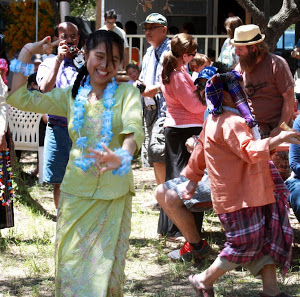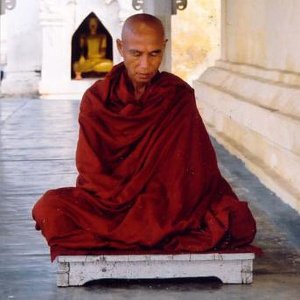I'm New: Questions and Answers
Where are you located?
We are on 23 acres in the St. Croix River area about forty minutes north of St. Paul, about ten miles east of Highway 35. Directions are on our contact page. The address is 32500 Lofton Ave., Chisago City, MN 55013.

I have driven by the temple and am curious. Can I drop by to look at the unusual structure and learn about what it is?
Yes. The structure is a pagoda. Please park in front of the residence house near the pagoda and ring the doorbell. If you are lucky one of the monks will appear and be glad to give you a tour. Otherwise you are welcome to wander around and let yourself into the pagoda if it is unlocked (after taking your shoes off).
What do you do at the Sitagu Dhamma Vihara?
The word vihara means "monastery," and we are the home of generally two to four monks. We serve also as a community center, especially on weekends for a largely Burmese community centered around St. Paul, and host a number of events each year (though anyone is welcome, and will feel welcome, to participate). We offer classes for adults and children on Buddhism, a contemplative environment for meditation, individual instruction and a variety of other opportunities for Buddhist practice and study, and to meet like-minded people.
I would like to learn about Buddhism and meditate.
Although you are welcome to make arrangements with the Burmese resident monks, who speak good English, at this time (2022), formal classes and meditation is primarily organized by our American monk, Bhikkhu Cintita, who is generally resident from April to October each year (please visit our contact page). Otherwise, to learn more, drop by and visit with one of the other monks.
How about community events?

As a community center we we sponsor many lively folk festivals with Burmese music, dancing and food. See our events page and our schedule. Non-Burmese always report feeling welcome at these events, and they enjoy an inter-ethnic experience for which they would otherwise have to make an expensive trip to Asia. Often on weekends a team of friends will show up as volunteers to build something or do some gardening.
Traditionally Burmese combine friendly visits, family outings and even participation in folk festivals with a number of devotional practices, offerings and short ceremonies, and paying respect to the monks. These are entirely optional, but you can ask one of the monks or many laypeople to explain them to you. Often they optionally involve offerings of flowers to the Buddha, food for the monks or other gifts, including financial donations to the monastery, ritual bows, taking of the refuges and precepts.
We also offer various services for special occasions.
What can I expect on my first visit?
You are welcome to drop by almost any time, but it is a good idea to phone or email ahead of time to make sure someone is here to greet you, especially if you are driving from afar. Typically you would call or email either the monastery or a specific monk (or a lay resident). It is often wise to check ahead of time before a scheduled event, in case there is some unanticipated change.
If you are dropping by, you may just be curious about us, want to do some sight seeing, want to learn about meditation or about Buddhist teachings, or want to know what practice opportunities we offer. We will be glad to give you a tour and answer any questions and whatever orientation you need.
If you come for a community event there will be many people you can
approach for orientation.
Sitagu Dhamma Vihara is a Burmese center, isn't it? Are Westerners and other non-Burmese welcome?
Yes, yes! The monastery is primarily supported by an ethnic Burmese community, but part of its mission is to make Buddhist teachings and practice available to all. Many "locals" have been active participants. As of this writing (2022) there is one American monk in residence for half of the year. Westerners consistently report that they feel very welcome no matter what events they come to. The monks almost always speak good English.
Do I have to be a Buddhist?
As long as you show due respect for the practices you will observe here, absolutely not. We respect all major religions or lack of thereof, and will not proselytize nor try to disrupt others' existing faith. Many people of other faiths report finding elements of Buddhist practice, most particularly meditation, very useful in their lives, and not only not challenging to their root faith but often very supportive of it. Feel free to talk with one of the monks about your needs and concerns and he will be glad to recommend what might and might not be appropriate for you.
Be aware that the beginning's of many events routinely begin with reciting the articles of Buddhist faith, known as Refuge in the Buddha, Dhamma and Sangha (the Buddha, the teachings and the monastic community). You are free to remain silent.
What points of etiquette should I know?
This is an excellent question because you will be coming not only to a monastery, but also into a largely Burmese cultural space (without the expense of flying to Rangoon). There are a number of conventional practices which you should be aware of and try to observe. But don't worry about the learning curve, people are very understanding that the general American culture tends to be very casual. The key elements are gestures of respect, especially toward monks and Buddha statues, and taking off shoes. A list of rules of thumb can be found HERE.
How much do you charge?
Nothing. We are supported by the generosity of our community which has always proved unwavering. We do not put any pressure on anyone to donate, nor announce "suggested donations." Many people are inspired to support our material needs because they have benefited personally from their participation here, others because they believe Buddhist practice, including yours, benefits all and so they want to support it. Traditionally the spontaneous offering of donations (dana) is considered a core Buddhist practice that brings much joy to its practitioners.
What is Theravada Buddhism?
In the world today there are three main schools of Buddhism: Theravada, Mahayana and Vajraya. In the ancient past there were many early schools of which only Theravada still survives, chiefly in Sri Lanka, Burma. Thailand, Cambodia, and Laos. Theravada is often referred to as the Southern School. The Mahayana and Vajraya were later, innovative traditions that began in India but continued to develop in the cultural contexts of East Asia and Tibet-Mongolia.

While there are significant differences between the schools, it is important to keep in mind that the basic, foundational tenets of the two schools are the same: The Four Noble Truths, The Eight-fold Noble Path, Karma Theory, Dependent Origination, etc. It is primarily in their differing emphases and historical develpments that the two schools differ. Their ultimate goal is the same: the perfection of character by following the teaching of the Buddha.
What is the role of monks?
The monks at Sitagu Vihara serve primarily as teachers of the Dhamma and meditation. The Sangha, the community of monks and nuns, was constituted by the Buddha in order to provide those of pure aspiration, who are willing and able to simplify their lives radically, an opporunity and support to base their lives entirely in Buddhist principles. In return they were made responsible for preserving and promoting the teachings and for ensuring that they are accurately transmitted to new generations. The monastic Sangha might well be the oldest human institution on the planet and, although not yet well known in the West, has historically always formed the backbone of the Buddist community. In the Burmese tradition it is common for people to ordain temporarily to experience what monastic life offers.



